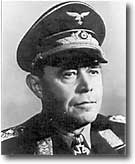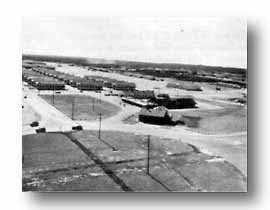THE T-PATCH
"Tell me, Field Marshal," persuaded Seymour Korman, Chicago Tribune war correspondent, "what do you consider the finest American Division to have opposed you?" Without looking up and without a moment's hesitation, Kesselring sputtered, "Your 3rd and 36th Infantry Divisions. I've been continually amazed by their audacity, at their long flanking tactics and the way they turned up in so many different places. I've had to pit my best troops against them." Even without tribute from captured enemy generals the "Texas" Division stands out as one of the truly veteran divisions of the Second World War. Girded with a spirit borne of fierce pride, the 36th made two amphibious assaults, at Salerno and on the Riviera, and saw intense action in four countries: Italy, France, Germany, and Austria during 366 days of combat operations.
In the formative years following, men of the Division bore the distaste of early army shortages, transformed a fledgling muddy camp into habitable quarters, "fought" with General Walter Kreuger's Third Army in the swamplands of Louisiana. It moved overland to sandy Camp Blanding, Florida, in February, 1942, and there was primed for an early overseas shipment. But orders changed, and so did the Division as cadres departed and recruits were added. After extensive maneuvers in the warm Carolinas during the summer, the 36th moved to a Yankee station on Cape Cod, Camp Edwards, Massachusetts. Here, living in tent cities, Division men practiced the then new art of amphibious operations, launched a mock invasion on Martha's Vineyard in late October. It was cold-tested at twenty degrees below zero in a blustery winter on the Cape. Parts of the Division engaged in a final, quick mountain maneuver at Piney River, Virginia, in March. Then on April 2, 1943, having come together from staging areas at Camp Edwards and Fort Dix, New Jersey, a solemn 36th sailed out from the New York Port of Embarkation and by fast convoy arrived at Oran, Algeria, eleven days later.
The Division formed the backbone of the newly organized Fifth Army. Serving as school-troops at the Army's Invasion Training Center on the Mediterranean at Arzew, it put through the paces the veteran 1st and green 45th Divisions before these shipped on the Sicily invasion. Then the 36th's own time came at Salerno, September 9, when all that the long months of training had prepared them for paid dividends as an unyielding 36th clung to the threatened beachhead. In so doing the 36th was justifying its proud heritage. Its history was one that dated back to 1835 and the Alamo when the 141st was born during the whirlwind of the Texas Revolution. In World War I the 36th "Lone Star" Division served in the Champagne sector during the Meuse-Argonne offensive, spent 23 days in active sectors, captured 813 men, 9 artillery pieces and 294 machine guns. Its record less brilliant than that of its 1943-45 counter-part, the 1918 36th fought in the same glorious tradition legendary with fighting men of Texas. In World War II, in nineteen months of combat, in five major campaigns, and in two amphibious assaults, the 36th Infantry Division had expended the maximum in heroism and hardship. The 36th is proud of its 175,806 enemy soldiers captured, its 15 Congressional Medals of Honor, its 10 Presidential Unit Citations, and numerous other battle awards. At the same time its casualty list, third highest of any American division, numbered 27,343, of whom 3,974 were killed, 19,052 wounded, and 4,317 missing in action. The 36th had had a tough time of it, but they had given more than they had taken. |

 The war had ended. So had the
career of a military intellectual who had chosen it as a lifetime profession. Field
Marshal Albert Kesselring, the ace defensive specialist and a connoisseur of matters
soldierly, sat hunched up on the corner of his cot brooding in retrospect, and puffing on
the last quarter of a bungled cigarette.
The war had ended. So had the
career of a military intellectual who had chosen it as a lifetime profession. Field
Marshal Albert Kesselring, the ace defensive specialist and a connoisseur of matters
soldierly, sat hunched up on the corner of his cot brooding in retrospect, and puffing on
the last quarter of a bungled cigarette.
